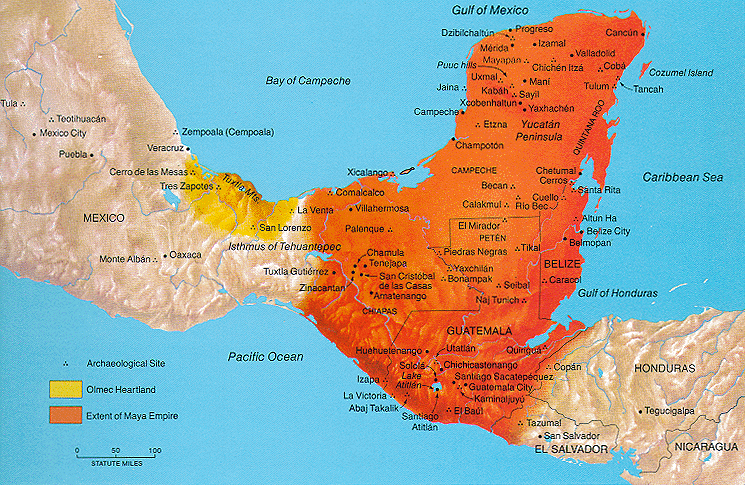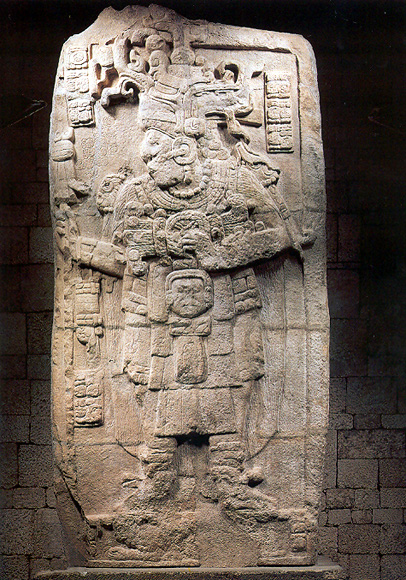Possibilities for how trade impacted the Maya economy
Archaeologists give three possibilities as to why trade occurred the way it did in the Ancient Maya world and by doing so help give understanding of the Ancient Maya economy. The first possibility is that there were tradesmen who walked routes and sold to the people of the city-states they passed. They could have also possibly set up in a marketplace type of environment as well as via a "coastal route." According to archaeologists this suggest a "more decentralized economy" in which people of different city-states choose how to interact with each other instead of being directed by centralized leadership.
The second possibility is that a ruler of a specific geographic area would have control over the import and distribution of many, to all, of the goods and services available for trade. This suggests a more centralized economy where interaction between city states, at least for trade purposes, was more a planned activity than one of happenstance.
The other option that is presented is that goods and services passed from city-state to city-state through individual trading. (McKillop 2004) However, more research still needs to be conducted in order to find out how this trade network actually occurred.
 Archaeologists do hypothesize that this intricate trade network that the Ancient Maya developed may have been a major factor in the rise and fall of the civilization. For instance, the salt trade is believed to have contributed to the dense population and "development of large cities in the northern plains of the Yucatan." The impact of the salt trade was directly related to the "centralization of wealth and power" that came with having "control of the Yucatan salt sources and coastal trade networks."
Archaeologists do hypothesize that this intricate trade network that the Ancient Maya developed may have been a major factor in the rise and fall of the civilization. For instance, the salt trade is believed to have contributed to the dense population and "development of large cities in the northern plains of the Yucatan." The impact of the salt trade was directly related to the "centralization of wealth and power" that came with having "control of the Yucatan salt sources and coastal trade networks."It is also believed that trade could have played a role in the collapse of the Ancient Maya. Archaeologist, Dr. Feinman, suggests that when trade routes switched from inland and coastal routes to mainly coastal routes that the people of the inland city-states were cut off from resources they needed to survive. How this cut off occurred Dr. Feinman isn't sure of but thinks that conflicts between city-states may have made trade to the inland impossible. (Golitko 2012) This would have also damaged the Maya economy to a point where it may not have been able to recover. Conclusion
Trade in the Ancient Maya world was very important to their economy and to the individual people who relied on trade for the resources they needed to have a successful everyday life. Trade had a major impact on religious activities, diet and interaction between Maya city-states and likely contributed to the Maya rising to the great civilization of the Classic period as well as contributing to its decline.
For more information on the Ancient Maya please visit the blogs below:
Ancient Maya Writing by Sarah Allaun
Ancient Maya Ritual and Statecraft by Taylor Sulouff
Maya Technology Involving Cosmology and Lunar Cycles by Juan Pomales
Maya Mythology in the El Mirador Basin by Elizabeth Peabody
Sources:
Golitko, M., Meierhoff, J., Feinman, G. M., & Williams, P. (2012). Complexities of collapse: the evidence of Maya obsidian as revealed by social network graphical analysis.(Method)(Report). Antiquity, (332), 507-523.
McKillop, H. (2004). The ancient Maya : New perspectives. Santa Barbara, Calif. : ABC-CLIO, c2004.
Figure Sources:
Figure 2: Golitko, M., Meierhoff, J., Feinman, G. M., & Williams, P. (2012). Complexities of collapse: the evidence of Maya obsidian as revealed by social network graphical analysis.(Method)(Report). Antiquity, (332), 512.




